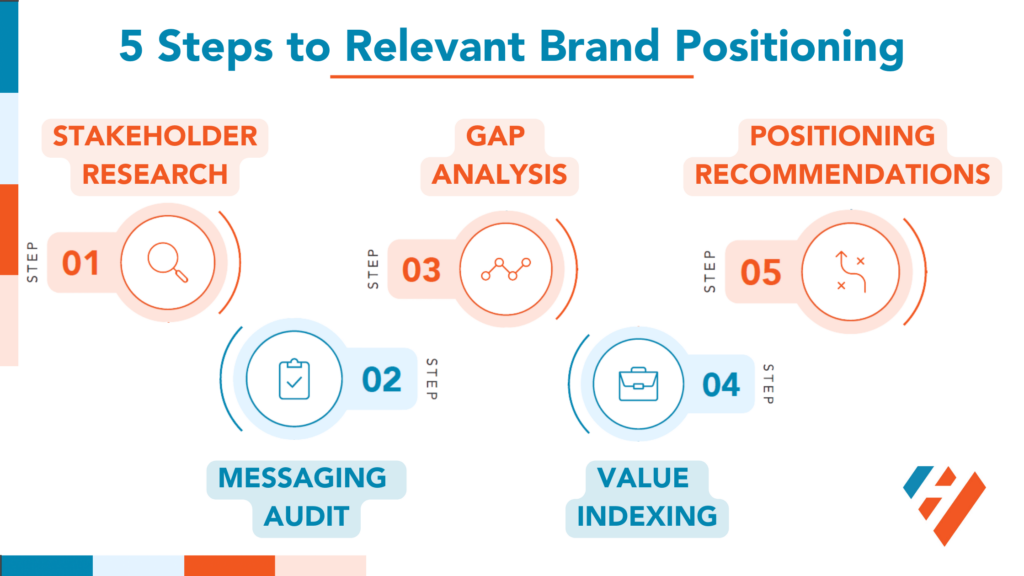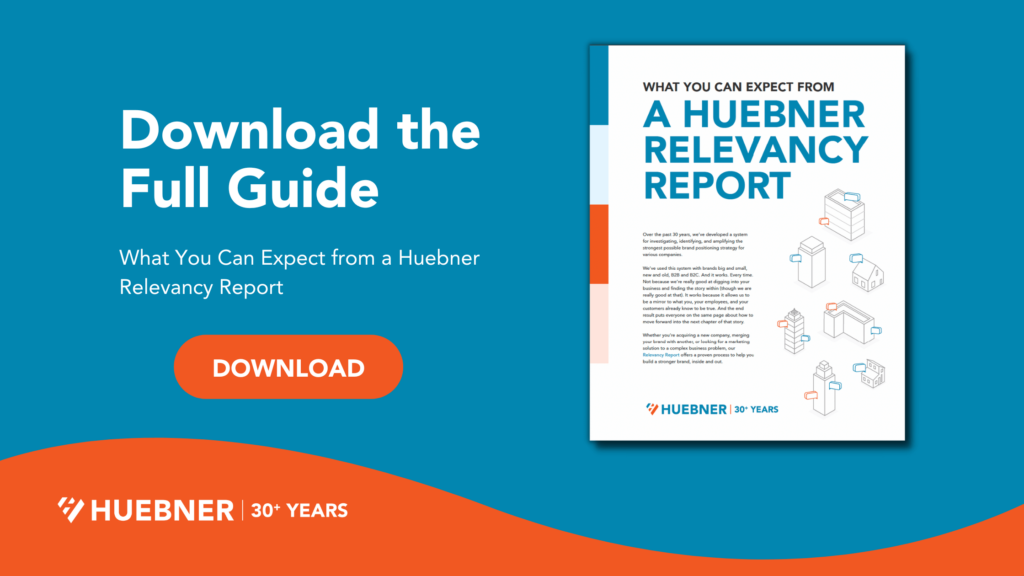Over the past 30 years, we’ve developed a system for investigating, identifying, and amplifying the strongest possible brand positioning strategy for various companies.
We’ve used this system with brands big and small, new and old, B2B and B2C. And it works. Every time. Not because we’re really good at digging into your business and finding the story within (though we are really good at that). It works because it allows us to be a mirror to what you, your employees, and your customers already know to be true. And the end result puts everyone on the same page about how to move forward into the next chapter of that story.
Whether you’re acquiring a new company, merging your brand with another, or looking for a marketing solution to a complex business problem, the foundational work of a brand positioning study offers a proven process to help you build a stronger brand, inside and out.
In this post, we’ll unpack what we’ve learned through the trial, error, and great success of brand positioning work.
Our Tried and True Brand Positioning Process
When it comes to evaluating your brand, you can’t cut corners. You have to take a deep dive, digging up weeds and tilling the soil to prepare for long-lasting fruit. Here’s how we approach a brand positioning study:
- Step 1: Research: Our team of pros visits your headquarters to talk to your stakeholders, your customers, and maybe even your competition.
- Step 2: Messaging Audit: We review what you say about yourself internally and externally—all of it.
- Step 3: Gap Analysis: We look for any gaps or inconsistencies between who you say you are and who the market believes you to be.
- Step 4: Value Indexing: Knowing what we know, we weigh the value of various brand positioning strategies.
- Step 5: Recommendations: We present a summary of our findings, including observations, strategies, and tactics to take advantage of your strongest brand positioning opportunities.
Each of the steps in our process is important in helping your brand get to the next level, and to ensure you don’t leave anything out.

STEP 01: RESEARCH
WHAT IT LOOKS LIKE:
During the research phase, we typically spend 1-2 days on-site with a client, talking to everyone from the receptionist to the head engineer to the CEO and their assistants. Our questions focus on both the why and the how of the business.
Following our on-site visit, we follow up with additional conversations with key customers, vendors, and even competitors to get a full 360-degree view of your business. We also often conduct an email survey of a broader audience to add additional context to our interviews.
WHY IT’S IMPORTANT:
The most common mistake we see in this kind of research is a lens that’s too narrow. Relying on one or two opinions (usually in the C suite) to make brand positioning decisions is a recipe for short-sightedness at best.
For the best results, you need input from a broad spectrum of stakeholders to gauge exactly where and how your brand sits in the minds of those connected to your brand.
The goal is to expose any and all perceptions of your brand— both positive and negative—and that usually involves collecting dozens of interviews.
STEP 02: MESSAGING AUDIT
WHAT IT LOOKS LIKE:
During the messaging audit, we collect everything we can find that carries your messaging. From brochures, web pages, and tweets to business cards, office signage, and customer service scripts.
It all adds up to the story you’re currently telling your team and the marketplace.
WHY IT’S IMPORTANT:
We strongly believe that your brand identity starts with your team and that messaging is born and tested around the water cooler. Bringing all your messaging to the surface—both internal and external—is the only way to fully understand your current brand position.
STEP 03: GAP ANALYSIS
WHAT IT LOOKS LIKE:
With interviews and messaging audits complete, our expert team goes into comparison mode … in a good way. During gap analysis, we’re looking for gaps between stakeholder perceptions, your current brand position, and your internal and external messaging. The result is a summary of where you stand and what opportunities we see for bridging those gaps.
WHY IT’S IMPORTANT:
This is where the third-party perspective is invaluable. Once you have these perception gaps defined, you can create a plan of action to move the organization forward to where you really want to be.
STEP 04: VALUE INDEXING
WHAT IT LOOKS LIKE:
By the time we get to value indexing, we have a pretty good handle on how you’re positioned currently and a number of ideas about how you might position your business more strongly in the future. We bring that list of ideas to the table and weigh them against what matters to your customers and how it compares to your competition. We use a simple scale of 10 to compare the power of say, “customer service leader” to “fastest delivery available.”
WHY IT’S IMPORTANT:
The challenge of this stage is to take a critical look at the potential directions your brand could go and weigh them against what the research has shown. While internally you might feel your customer service is most important, if your customers are more interested in delivery times, that has to be considered. What is it they say about the customer being right?
STEP 05: RECOMMENDATIONS
WHAT IT LOOKS LIKE:
We deliver our recommendations in a written report summarizing everything we learned and observed about your business, complete with the positioning strategies we believe offer the most potential for adding value to your brand.
This final report is a tool to bring key stakeholders to the table to decide the next steps as a team with solid data to support your decision.
Most likely, it will take the leadership team— including the CEO—to make the final decision on the positioning strategy.
WHY IT’S IMPORTANT:
The end product is truly just the starting point, a way to get everyone on the same page, and a resource to return to when things inevitably change.
Once the most promising brand positioning strategy is determined, we recommend these three additional exercises to kick off the next phase of benefit the brand offers to the customer, your stronger, more relevant brand:
- A positioning statement should be written that clearly articulates how the brand is being positioned against its competitors, what the brand promises, and how it’s differentiated from its competitors. The positioning statement can be anywhere from 1 to 5 paragraphs in length.
- A tagline should be written that summarizes the positioning statement in a short, creative, and memorable way. Ideally, the tagline should convey the primary making the customer strategically aware of what makes it unique.
- A roadmap should be established—led by the VP of Sales & Marketing (or similar)—to ensure best practices are undertaken to meet goals, objectives, and any KPIs related to communicating the brand position and marketing it for strategic awareness in the marketplace.
Brand positioning, like many marketing efforts, gets a bad reputation when it comes to ROI. It’s fuzzy to measure the impact of a new tagline or a change in how you talk about your company internally. But we’re not afraid of a little metrics talk.
The true ROI of a brand positioning study depends on the business goals that led to the project in the first place.
Depending on that core objective, we can measure our success through brand equity surveys, employee net promoter scores, brand awareness in a new market, growth beyond sales projections—the list goes on and on.
We typically follow up a brand positioning study with a Relevancy Roadmap, a marketing plan designed to support big-picture business objectives and create clarity for your marketing strategy—and spend. We can help identify roadblocks, find ways to alleviate them, and lay out a roadmap of tactics that can have the biggest impact on your business.
READY TO MAXIMIZE YOUR RELEVANCE?
Contact the team at HUEBNER MARKETING to kick off a Relevancy Report or discuss additional ways we can support your marketing goals.

